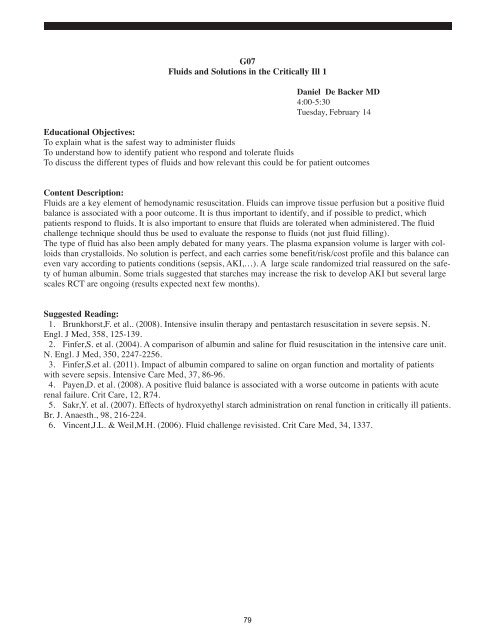ABSTRACTS from 16th International COnference on ... - CRRT Online
ABSTRACTS from 16th International COnference on ... - CRRT Online
ABSTRACTS from 16th International COnference on ... - CRRT Online
Create successful ePaper yourself
Turn your PDF publications into a flip-book with our unique Google optimized e-Paper software.
G07<br />
Fluids and Soluti<strong>on</strong>s in the Critically Ill 1<br />
Daniel De Backer MD<br />
4:00-5:30<br />
Tuesday, February 14<br />
Educati<strong>on</strong>al Objectives:<br />
To explain what is the safest way to administer fluids<br />
To understand how to identify patient who resp<strong>on</strong>d and tolerate fluids<br />
To discuss the different types of fluids and how relevant this could be for patient outcomes<br />
C<strong>on</strong>tent Descripti<strong>on</strong>:<br />
Fluids are a key element of hemodynamic resuscitati<strong>on</strong>. Fluids can improve tissue perfusi<strong>on</strong> but a positive fluid<br />
balance is associated with a poor outcome. It is thus important to identify, and if possible to predict, which<br />
patients resp<strong>on</strong>d to fluids. It is also important to ensure that fluids are tolerated when administered. The fluid<br />
challenge technique should thus be used to evaluate the resp<strong>on</strong>se to fluids (not just fluid filling).<br />
The type of fluid has also been amply debated for many years. The plasma expansi<strong>on</strong> volume is larger with colloids<br />
than crystalloids. No soluti<strong>on</strong> is perfect, and each carries some benefit/risk/cost profile and this balance can<br />
even vary according to patients c<strong>on</strong>diti<strong>on</strong>s (sepsis, AKI,…). A large scale randomized trial reassured <strong>on</strong> the safety<br />
of human albumin. Some trials suggested that starches may increase the risk to develop AKI but several large<br />
scales RCT are <strong>on</strong>going (results expected next few m<strong>on</strong>ths).<br />
Suggested Reading:<br />
1. Brunkhorst,F. et al.. (2008). Intensive insulin therapy and pentastarch resuscitati<strong>on</strong> in severe sepsis. N.<br />
Engl. J Med, 358, 125-139.<br />
2. Finfer,S. et al. (2004). A comparis<strong>on</strong> of albumin and saline for fluid resuscitati<strong>on</strong> in the intensive care unit.<br />
N. Engl. J Med, 350, 2247-2256.<br />
3. Finfer,S.et al. (2011). Impact of albumin compared to saline <strong>on</strong> organ functi<strong>on</strong> and mortality of patients<br />
with severe sepsis. Intensive Care Med, 37, 86-96.<br />
4. Payen,D. et al. (2008). A positive fluid balance is associated with a worse outcome in patients with acute<br />
renal failure. Crit Care, 12, R74.<br />
5. Sakr,Y. et al. (2007). Effects of hydroxyethyl starch administrati<strong>on</strong> <strong>on</strong> renal functi<strong>on</strong> in critically ill patients.<br />
Br. J. Anaesth., 98, 216-224.<br />
6. Vincent,J.L. & Weil,M.H. (2006). Fluid challenge revisisted. Crit Care Med, 34, 1337.<br />
79
















